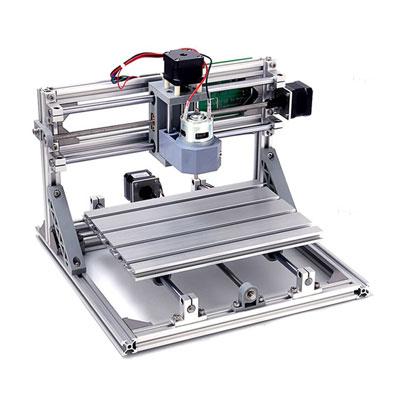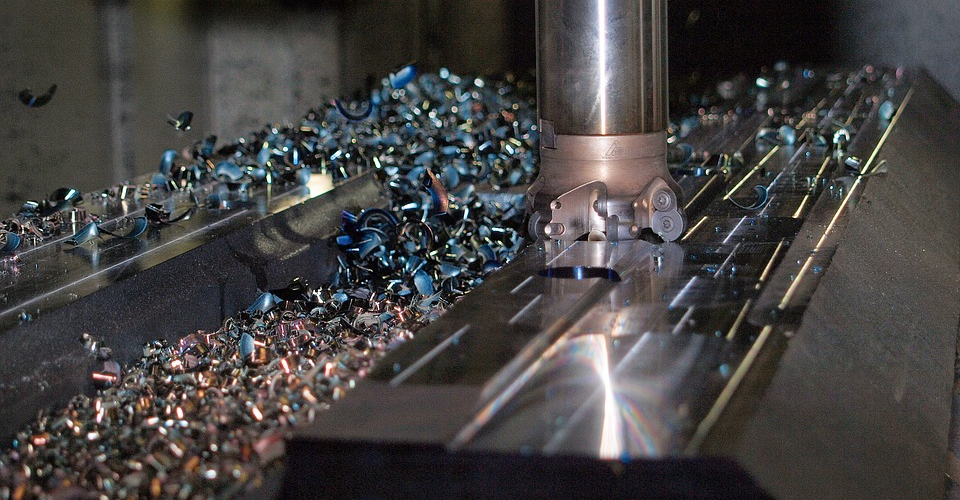What is CNC machining?
CNC stands for Computer Numeric Control. It is a machining technique used in the subtractive form of manufacturing. As the word subtractive may suggest, CNC involves removing material from a solid block in order to create the final design which is created in a CAD file. This material is removed using a variety of cutting tools.
This technique is fundamentally different from modern technologies like 3D printing, which is additive in nature, and injection molding, which is a formative manufacturing technique. CNC machining involves the use of a computer to control advanced machines like grinders, routers, lathes, and mills.
CNC machining is a highly automated process and delivers a high level of accuracy. Because of computer usage, tolerance accuracy can be as low as 0.001. Human error is almost eliminated with automation and computers. Parts which require precision and high-accuracy are often machined using CNC machining.
CNC is an economical and price-competitive technique for medium volume lots and even one-off custom units. However, the technique is most cost-effective when production volumes are large and the parts are identical. CNC machines can save money and time by working faster than conventional processes.
Almost every kind of material can be used with the CNC machining technique. However, the most commonly used materials are metals like aluminum, steel alloys, and brass as well as plastics like Nylon, ABS, and Delrin. Wood and foam material can also be CNC machined.
History of CNC Machining
Machined objects have long been used by humans. One of the earliest records of machined objects points to a bowl made in Italy around the year 700 B.C. This bowl was made using a lathe. Since then, various machining tools like lathe, mills, routers, and grinders have been used to machine objects.
Most of this machining was manual. Efforts to automate the process started in the 18th century. Automated machines were steam-powered. But with the advancement in electronics, the first CNC machines as were built around the mid-20th century. MIT developed the first known programmable machine which used punch cards to encode its movement.
During the 1940s, the CNC machines were simply called NC machines. The “C”, which stands for computer, came around the 1950s and 1960s with advancements in the field of computer engineering. The use of computers transformed the machining and manufacturing industries.
Fast forward to the 21st century and we now have CNC machines which are highly advanced. They are robotic in nature and can operate in multiple axes. The tooling capabilities of modern CNC machines are also very advanced.
Main steps of the CNC machining process

CNC machining involves 3 major steps. The first step is designing. In this step, a designer or an engineer will design the part that needs to be machined in CAD software. The CAD file will have all the details about the design of the part in a visual format.
The second step is the conversion of the visual CAD model into a numeric G-code. G-code is what the CNC machine reads and understands. It has information on where the machine needs to move and what functions it needs to perform at specific coordinates.
Once the G-Code is ready, it is loaded onto the machine and a test run is performed. This test run is known as “cutting the air”. The test run is an important step because it allows the user to observe if the code is working as per the design that the part is intended to have.
If something is not right, then the test run provides the opportunity to rectify any errors. Not going through a test run can create a scrapped part or even damage the CNC machine. Hence, the code needs to be verified and approved via a test run before moving onto the production run.
The third step is the creation of the part. Once everything is tested and ready, the CNC machine and the computer takes over and starts machining parts with very little to no human intervention. The CNC machine can go on for hours and machine many parts without any interruptions.
The different types of CNC machines
There are two main families of CNC machines. The first one is a 3-axis machine and the second is a multi-axis machine.
Under the 3 axis system, there is a CNC milling machine and a CNC turning machine. CNC milling machines are very common, they have low set-up costs, and they can machine the most common geometries. CNC turning machines are also called CNC lathes. These machines are used in high volume production works and can machine parts with high speeds.
Under the multi-axis system, we first have the 5-axis indexed milling machine, which is also known as the 3+2 indexed machine. The machine axis moves along 3 axes while the bed and tool head can also move along different angles. However, the bed and tool head can only be moved in-between operations.
The second type of machine is the 5-axis continuous milling machine, which is a slightly improved version of the indexed milling machine. It allows movement of all 5 axes during the machining operation, hence the word continuous.
Lastly, we have CNC mill-turning machines. These are CNC lathe machines with milling tools. So, they have the high productivity of CNC lathes along with the geometric flexibility of CNC milling. Parts like impellers and camshafts are ideal candidates for machining using a 5-axis mill-turning system.
What industries use CNC machining?

CNC machines have found applications in a wide variety of industries. The most interesting industry is space. CNC machining is one of the few techniques that have the required precision and accuracy that is needed in space applications. Besides, CNC machined parts can also be surface-treated with multiple types of treatments.
Another industry closely associated with space is aerospace, which also happens to be a popular area for CNC machining. Lightweight parts with very focused tolerance levels can be machined using CNC machining. The physical properties of CNC machined parts are also good enough for aircraft components.
Automotive and design companies like the CNC machine because it allows them to build customized parts. Whether it is prototypes or final parts, CNC machines find use with auto and product-design industries.
As CNC machining is a subtractive form of manufacturing, it removes material to make the final design. Less material means lower weight. Hence, the sports industry enjoys the benefits of the CNC technique. Motorsports and other sports involving movement and mobility are always on the lookout for lighter equipment/components. CNC machining fits that requirement pretty well.
There are plenty of uses for CNC machines in industrial environments. Injection molded parts are machined using the technique. Manufacturing, oil and gas, and heavy industrial machinery use CNC machines as well for making components and housing parts. Junction boxes that house various electronic components are also CNC machined.
What are the advantages of using CNC machines?
CNC machining has many advantages over other machining techniques. The most coveted advantage of CNC machining is its high accuracy. The computerization of this process means that the chance of human error is almost nil. CNC machining can also remove material from a workpiece with high accuracy. This results in very low and tight tolerance levels.
You will be amazed to know that CNC machines can work with tolerance ranges of 0.05mm to 0.025mm. We are talking about the width of a human hair with such low numbers. This technique can even hit a tolerance level of 0.001.
Along with the accuracy, the ability of a CNC machine to keep repeat manufacturing the same design over and over is another significant benefit. Manual methods will not be able to repeatedly machine identical designs with such high accuracy.
The repeatability also leads to cost-efficiencies. Small and medium production lots of 10 units to 100 units can reduce the cost of machining by 70% when compared to the cost of machining just one unit. The fixed cost of setting up the CNC process gets divided among a larger number of units and that is what leads to cost savings.
3D printing is not known to be able to scale up very well for 10s and 100s of units. On the other end of the spectrum, a technique like injection molding only makes sense of 1000 units or more are to be manufactured. CNC machining is situated at a nice sweet spot in between the two ends of the spectrum.
CNC machining is not a time-consuming process. Advancements in CAM software and in CNC systems have resulted in a turnaround time of just a few days. That brings modern CNC systems on par with industrial 3D printers.
Lastly, CNC machines support multiple materials. They also give products with great material properties. Any material with a certain level of hardness can be CNC machines. Whether it is metal or wood, CNC machines can handle it all.
What are the disadvantages of using CNC machines?
CNC machines have excellent advantages that are listed out above. But that does not mean there are no downsides. The CNC process has its own weaknesses which are discussed below.
The first downside is the relatively high start-up cost. While the start-up cost may not be as high as injection molding, there is considerable planning necessary to get things going. One needs to have a designer work on CAD modeling. Other expert opinions from highly skilled professionals are necessary. Such human capital is expensive. The only way to absorb these high initial costs is by machining more parts during the production run so that the fixed costs get spread out over a larger volume.
Complex designs and geometries make the CNC machining process more complex and expensive. Since CNC is a subtractive form of manufacturing, there are limits to what the mechanics of a CNC machine can achieve. For more advanced designs, multi-axis machines may be necessary or manual work from a machinist might be the only option for the final details to be machined. The use of such special machines and manual labor can be an expensive proposition.
There are other technical challenges with CNC machining. For example, if a part does not have a high stiffness level, then holding it in place will not be easy. Unsecured holding will lead to vibrations during the machining process and that, in turn, will compromise the tolerance levels and the accuracy. Certain types of designs like steep undercuts and certain internal geometries are not possible to machine with the CNC technique because the cutting tool can only reach certain surfaces and certain positional planes.

